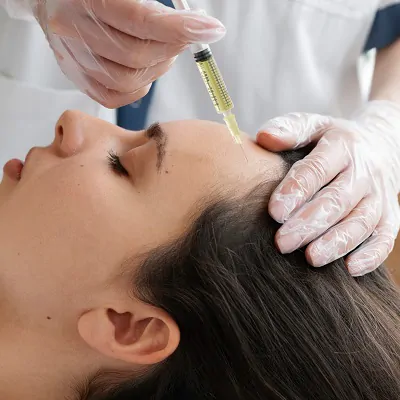
Hair thinning and hair loss are common concerns among women, affecting their confidence and self-esteem. Fortunately, PRP (Platelet-Rich Plasma) therapy offers a promising solution to this issue. PRP in Islamabad has gained popularity as a non-surgical treatment for stimulating hair growth and restoring lost volume. In this article, we will delve into the benefits of PRP for women, how it works, and what you can expect from this innovative treatment.
If you’re considering PRP in Islamabad, learn more about how this treatment can help restore your hair by visiting Dynamic Clinic PRP in Islamabad.
What is PRP Hair Treatment?
PRP hair treatment is a non-invasive procedure that uses your own blood to stimulate hair growth. The process involves drawing a small amount of blood from your arm, which is then processed to concentrate the platelets. These platelets are rich in growth factors that help repair damaged hair follicles, stimulate the growth of new hair, and improve the overall health of the scalp.
How PRP Works for Women’s Hair Loss
PRP therapy for women’s hair loss involves the following steps:
-
Blood Collection: A small sample of your blood is drawn.
-
Centrifuge Processing: The blood sample is placed in a centrifuge to separate the platelet-rich plasma from other components.
-
Injection into Scalp: The PRP is then injected into the scalp, focusing on areas where hair thinning or baldness is most noticeable.
-
Hair Regeneration: The growth factors present in the PRP encourage the repair of hair follicles and stimulate the production of new, healthy hair.
PRP for Women’s Hair Thinning: The Benefits
PRP therapy offers numerous benefits for women dealing with hair thinning and loss, including:
-
Natural Treatment: Since PRP uses your own blood, the risk of allergic reactions or complications is minimized.
-
Non-Surgical Procedure: Unlike hair transplant surgery, PRP does not require any cuts or stitches, offering a less invasive approach.
-
Minimal Downtime: You can resume your daily activities almost immediately after the procedure.
-
Safe and Effective: PRP promotes hair regrowth by stimulating dormant hair follicles without the need for harsh chemicals or medications.
Ideal Candidates for PRP Hair Treatment
PRP therapy is suitable for women who are experiencing hair thinning or early stages of hair loss. It can also be effective for those with androgenic alopecia (female-pattern baldness). However, for women with advanced hair loss or extensive baldness, PRP might not be as effective. Consulting with a hair restoration specialist can help you determine if PRP is the right treatment for your condition.
What to Expect During a PRP Session
A typical PRP session for women lasts about 60 to 90 minutes and consists of the following steps:
-
Consultation: A hair restoration specialist will assess the extent of your hair loss and discuss your goals.
-
Blood Draw: A small amount of blood is collected from your arm.
-
Platelet Separation: The blood is processed in a centrifuge to isolate the platelets.
-
Injection: The PRP is injected into the scalp at the areas of hair thinning.
After the treatment, you may experience mild redness or swelling, but this typically resolves within a few hours.
How Many PRP Sessions Are Needed?
The number of PRP sessions required depends on the extent of hair loss and how well the patient responds to the treatment. Typically, women will need:
-
Initial Phase: 3-4 sessions, spaced 4–6 weeks apart.
-
Maintenance Phase: One session every 4–6 months to maintain results.
Results usually start to become visible after the third or fourth session, with continued improvement over the following months.
Results and Expectations
While PRP is effective, it is important to manage expectations. PRP therapy does not offer overnight results. It typically takes several months to see significant improvements. Over time, patients may notice:
-
Thicker, fuller hair: Hair appears denser and healthier.
-
Reduced shedding: Hair fall significantly decreases.
-
New hair growth: Fine, baby hairs begin to grow in areas of thinning.
The full results of PRP therapy for hair restoration are usually visible after 6–12 months of consistent treatment.
PRP vs. Other Hair Treatments for Women
PRP therapy is a great alternative for women who are hesitant to undergo surgical procedures like hair transplants. Unlike medications or topical treatments, PRP offers a natural solution by utilizing your own blood. Additionally, it carries fewer risks than invasive surgeries and requires minimal recovery time.
However, for women with advanced hair loss or significant bald patches, other options such as hair transplants may be more suitable. A consultation with a hair specialist can help you determine the best treatment option.
Is PRP Hair Treatment Safe for Women?
Yes, PRP therapy is considered safe for most women, as it uses your body’s own blood. However, there are some risks associated with any procedure, including:
-
Mild swelling or redness: This is temporary and typically resolves within a few hours.
-
Scalp sensitivity: Some patients may experience mild discomfort or tenderness at the injection site.
-
Bruising: Rarely, a small bruise may appear at the injection site.
These side effects are generally mild and subside quickly, allowing you to resume your daily activities.
How Much Does PRP Hair Treatment Cost for Women in Islamabad?
The cost of PRP therapy for women in Islamabad can vary depending on the clinic and the number of sessions required. On average, the cost per session can range from PKR 10,000 to PKR 20,000. Many clinics also offer package deals that make the treatment more affordable when multiple sessions are booked at once.
Conclusion
PRP hair treatment is a safe, effective, and natural option for women struggling with hair thinning or loss in Islamabad. With minimal downtime and impressive results, it has become a popular choice for women looking to restore their hair. If you are considering PRP, consult with a certified specialist to determine if it’s the right treatment for you. Start your journey toward fuller, healthier hair with PRP therapy today.